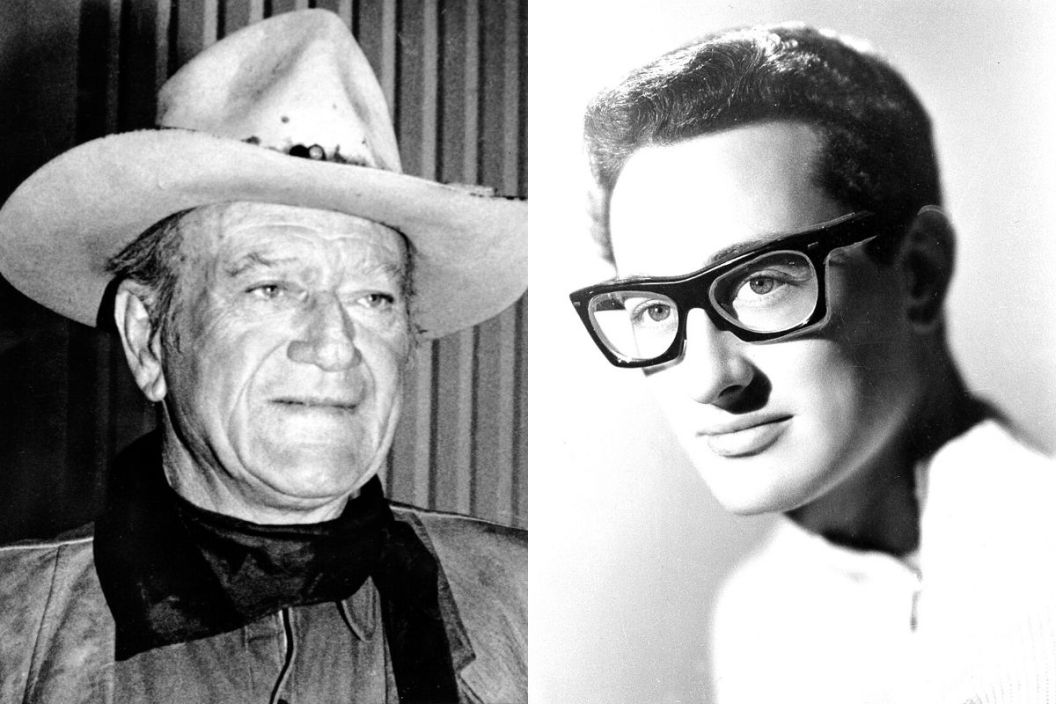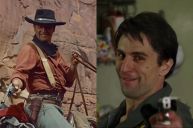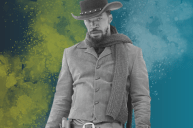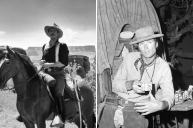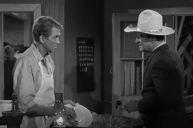"That'll be the day!" Throughout The Searchers, John Wayne's character, the gruff Ethan Edwards, invokes this phrase to express skepticism. By this point, it's a common saying but in 1956, Edwards' motto -- and general attitude -- was a new to audiences. In addition to becoming a massive commercial success, The Searchers has gone down in cinema history and spawned various artistic responses. Among them, "That'll Be the Day" by Buddy Holly.
Videos by Wide Open Country
The Impact of 'The Searchers'
The director John Ford is typically associated with classic Western filmmaking. His most famous films include Stagecoach, The Man Who Shot Liberty Valance, and Grapes of Wrath (not exactly a Western, but a mainstream epic all the same). However, The Searchers, which premiered in 1956 marked a radical departure from the narratives we associate with Ford -- and his leading man John Wayne.
Starring as the former Confederate soldier Ethan Edwards, Wayne did not look or act like previous on-screen cowboys. He was, frankly, unlikable. Prone to racist rants and exaggerated shows of machismo, the Edwards was not the Wayne hero audiences were expecting. After spending years on the frontier, searching for his kidnapped niece Debbie (Natalie Wood), Edwards eventually finds her indoctrinated into the Comanche tribe -- and wants to kill her for it! This complex, hateful characterization inspired the sprawling sub-genre of revisionist Westerns that followed. The success of The Searchers also manifested our national fascination in anti-heroes. (An interesting example? Robert De Niro as Travis Bickle: the sleazy protagonist of Martin Scorsese's Taxi Driver.)
And, it turns out, the Western also inspired the young rocker, Buddy Holly.
Read More: What Is a "Revisionist Western"?
"That'll Be the Day"
Ethan Edwards uses the term "That'll be the day," indignantly, throughout the film. But perhaps the most memorable moment occurs after he and his partner Martin Pawley (Jeffrey Hunter) find Debbie living happily with her Native American captors. Edwards, severely injured, writes up a will and asks Pawley to read it out loud. In the legal document, Edwards entrusts his belongings entirely to Pawley considering he is "without any blood kin." This enrages Pawley, who insists that Debbie is Edward's family:
"Well, Debbie's your blood kin."
"Not no more she ain't!"
"Well you can keep your will! I don't want any of your property. 'Sides, I ain't forget you was getting all set to shoot her yourself. What kind of a man are you anyways!"
"She's been living with a buck. She's nothing but--"
"Shut your dirty mouth! I hope you die."
"That'll be the day."
In this volatile moment, Pawley is so overcome by emotion that his voice cracks. When he tells Edwards he wants him to die, it's almost too much to bear. But the flat and sardonic response from Edwards undercuts the intensity of that scene, thanks to Wayne's growly delivery. It's an odd choice, considering Edwards is so seriously injured that he is devising a will. But in rebuking Pawley's offense, Edwards remains in control a little longer. However, the confident idiom sounds quite different in the Buddy Holly song, which would rule the American radio waves just a year later.
Buddy Holly and the Crickets
Charles Hardin Holley, a.k.a. Buddy Holly, was born in Lubbock, Texas in 1936 to a musical family. When the budding singer-songwriter was in high school, he joined forces with fellow students Sonny Curtis and Jerry Allison. They played locally and were inspiring by the rising star Elvis Presley. After opening for Presley in 1955, the Nashville scout Eddie Crandall helped Holly secure a contract with Decca Records. But the label did not offer Holly the creative freedom he craved. So the musician left for New Mexico to record with producer Norman Petty: the version of "That'll Be the Day" that we know today was created there, in 1956. At Decca, frontman Holly had been allowed to play lead guitar. But recording with Petty, Holly took over as the guitarist and re-recorded "That'll Be the Day" to his liking. That demo was eventually sent to Brunswick Records in New York City, where it was released under the name The Crickets. At the time, Holly was under contract with Decca and could not use his own name. His original bandmates Jerry Allison, Joe B. Mauldin, and Niki Sullivan would continue under the moniker even after Holly's breakout stardom.
According to legend, Holly came up with the idea for the song after watching The Searchers in theaters back in Lubbock. Sitting beside his drummer Allison, as the movie ended, Holly said, "It sure it would be nice if we could record a hit song." Allison's pithy response? "That'll be the day!" Of course, by the fall of 1957, "That'll Be the Day" was #1 on the Billboard charts. And just a month later, "Peggy Sue" was released: another phenomenal hit for Buddy Holly and the Crickets.
The lyrics of "That'll Be the Day" are addressed to a girl: the singer's romantic partner. She continually rebuffs any future with the singer, a fact that could make the song sound like a heartbreak ditty. But in employing "That'll be the day" -- an established sarcastic motto -- the girl's attempts to break up seem futile. "You say you're gonna leave, you know it's a lie," Holly croons. Like Edwards, he verbally retains his power -- even when all signs point to defeat. The cheeky message invites further speculation and marked a deep departure from the previous pop songs of the '50s.
The Day the Music Died
In the winter of 1959, Holly and his musical friends flipped a coin to decide who would fly to the next tour top in four-seat Beechcraft Bonanza -- and who would get stuck taking the cold tour bus. In the end, Holly boarded the plane along with Chicano rock sensation Ritchie Valens, the Big Bopper (J.P. Richardson). Holly's band, which included Waylon Jennings at the time, would go by car. And despite dangerous weather, the plane took off, piloted by Roger Peterson.
On February 3, 1959, the aircraft crashed into a cornfield near Mason City, Iowa. Everyone on board was killed instantly. Holly was just 22 years old. Don McLean reflects on the tragic plane crash in his most famous song, "Miss American Pie." The excellent biopics The Buddy Holly Story and La Bamba also, naturally, cover the story. History has never forgotten about Holly. In 1986, he was posthumously inducted into the Rock and Roll Hall of Fame.
And as the decades continue to pass, "That'll Be the Day" remains an enduring rock 'n' roll hit: a favorite among the many Buddy Holly songs.
The Quarrymen
The Quarrymen, a Liverpool group that included John Lennon and Paul McCartney prior to the forming of The Beatles, have their own bluesy cover. Listen to the 1958 cover above.
Linda Ronstadt
Released in 1976 on her Grammy-winning album Hasten Down the Wind, Linda Ronstadt's version of "That'll Be the Day" was another popular cover. Her recording was also included on the two compilation albums Linda Ronstadt's Greatest Hits and Listen to Me: Buddy Holly.
